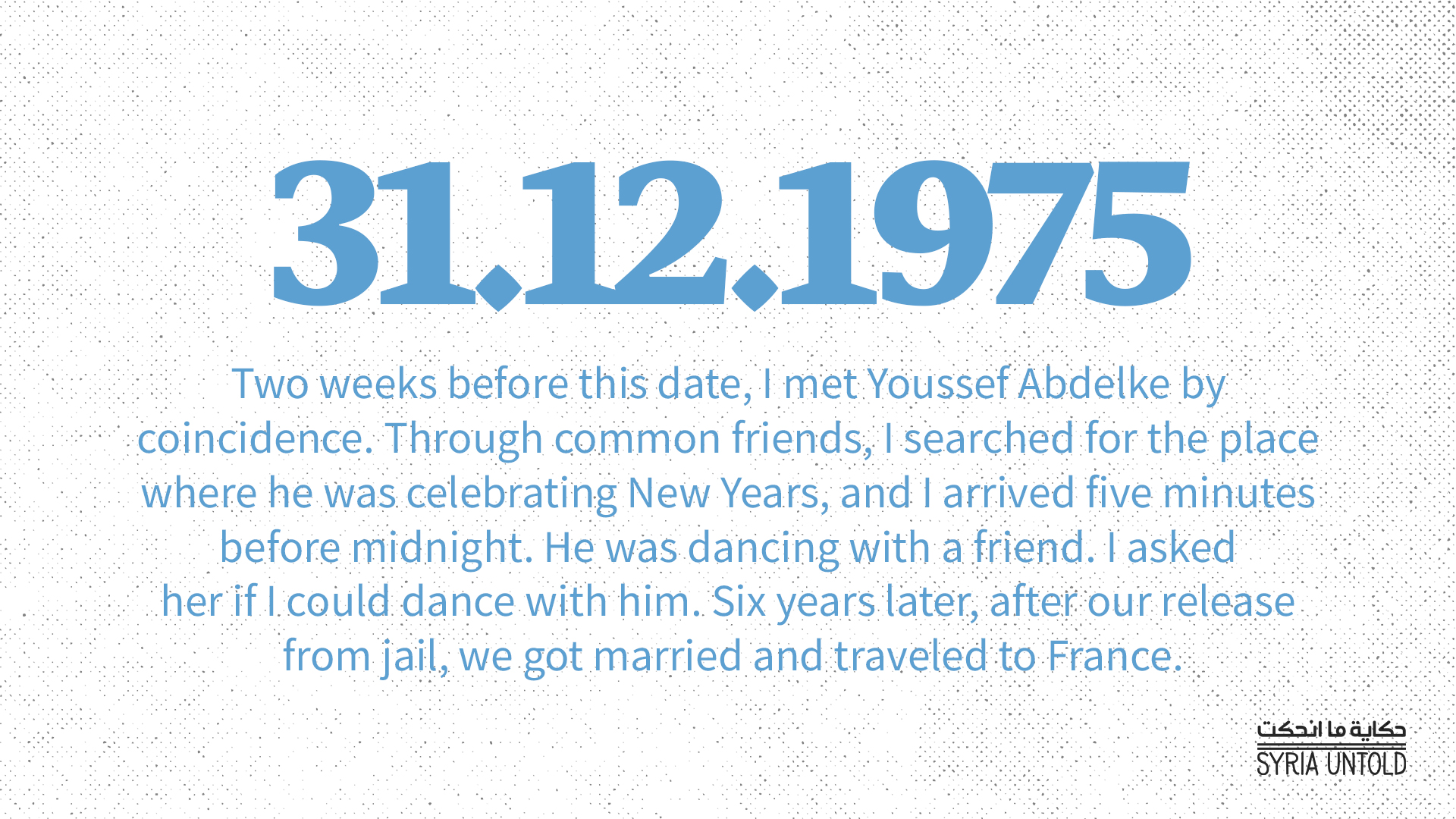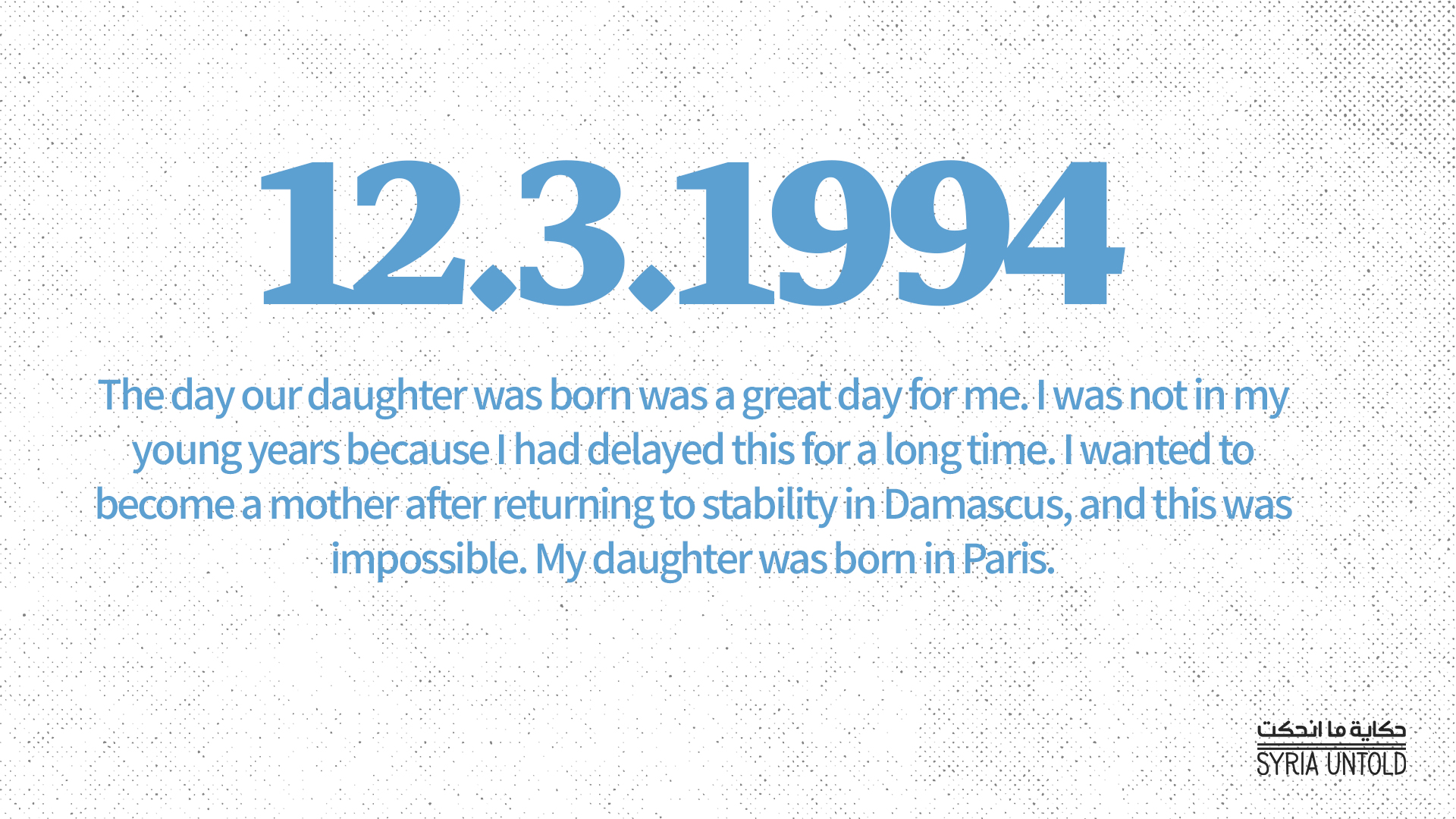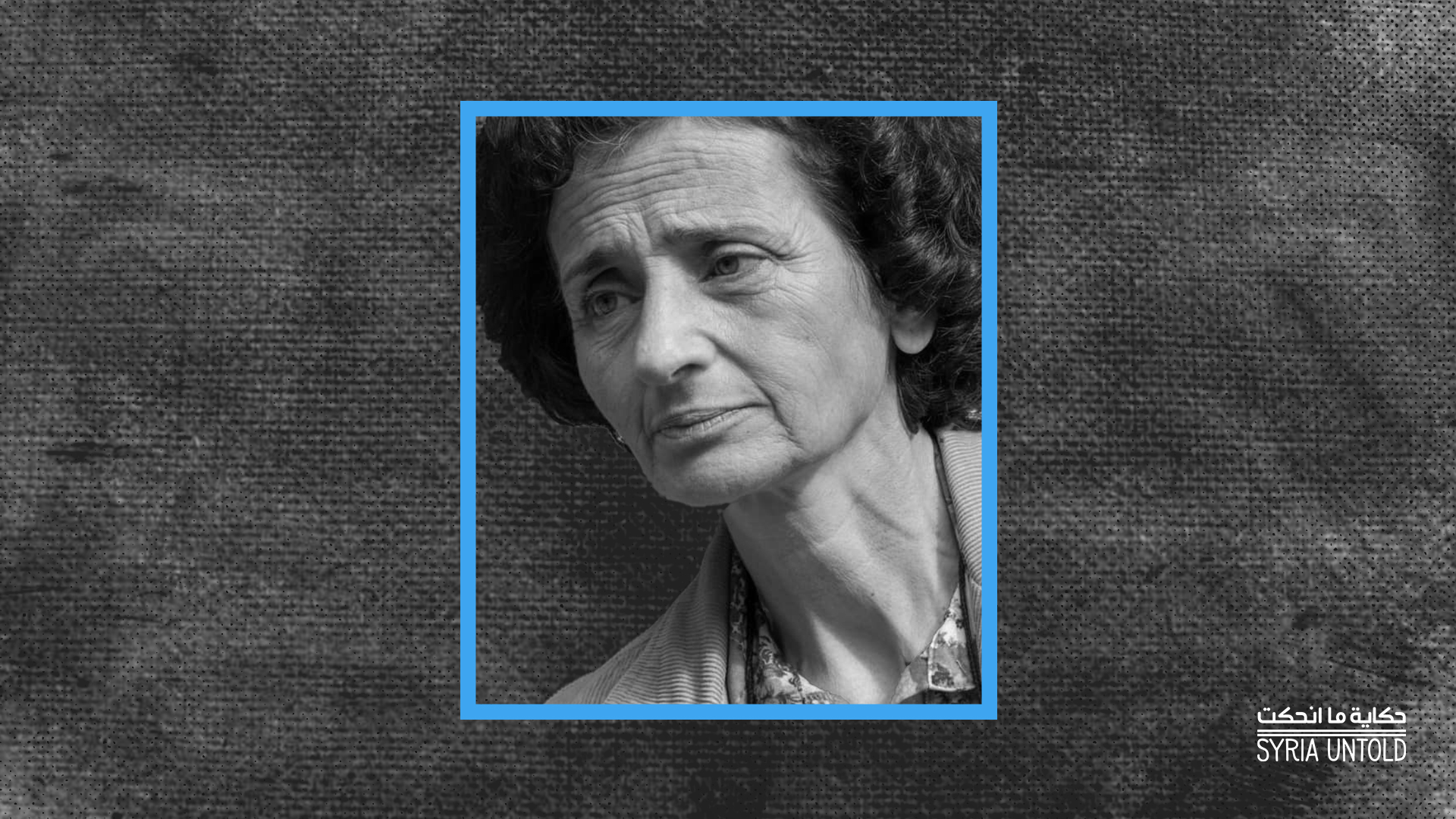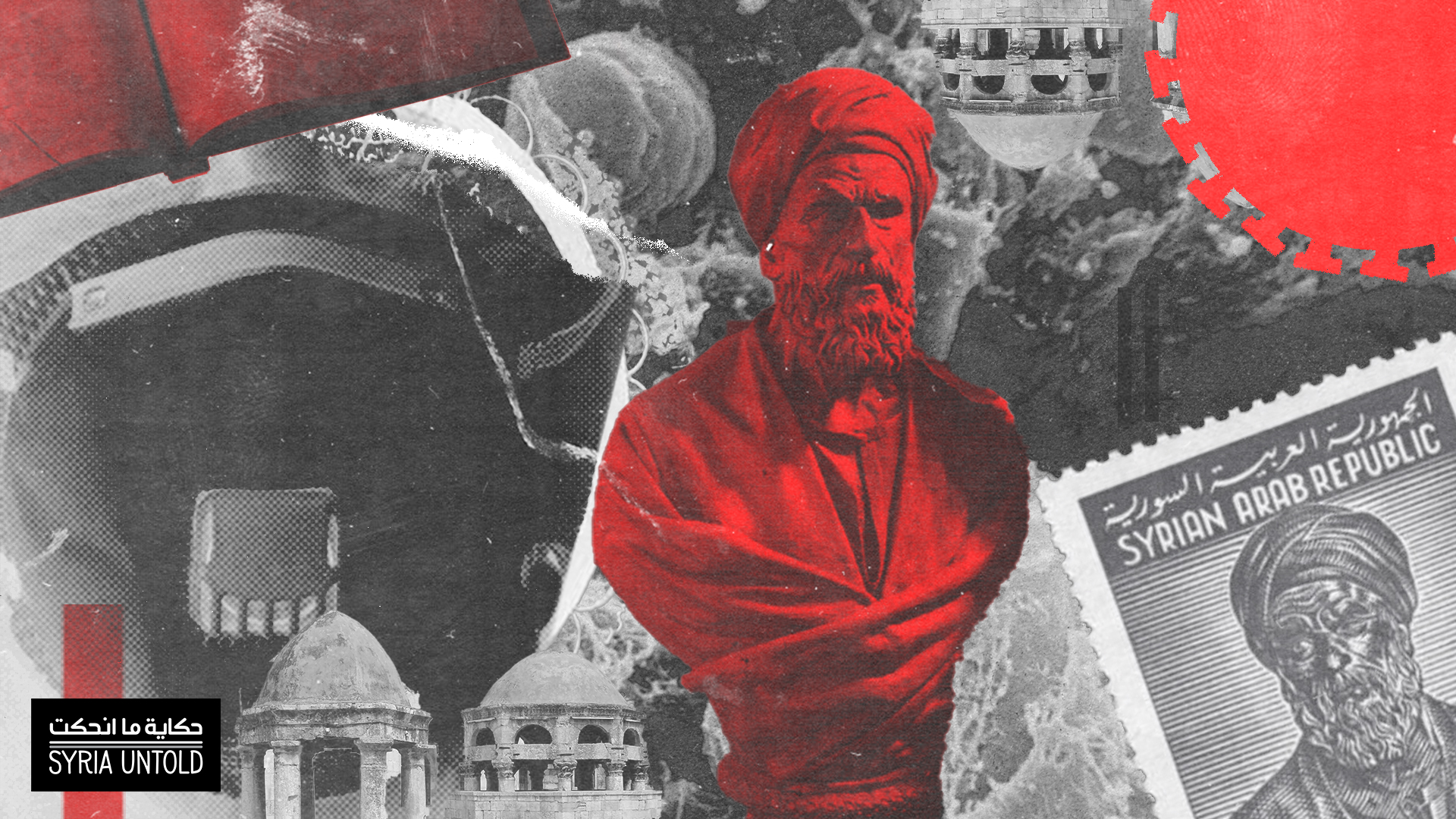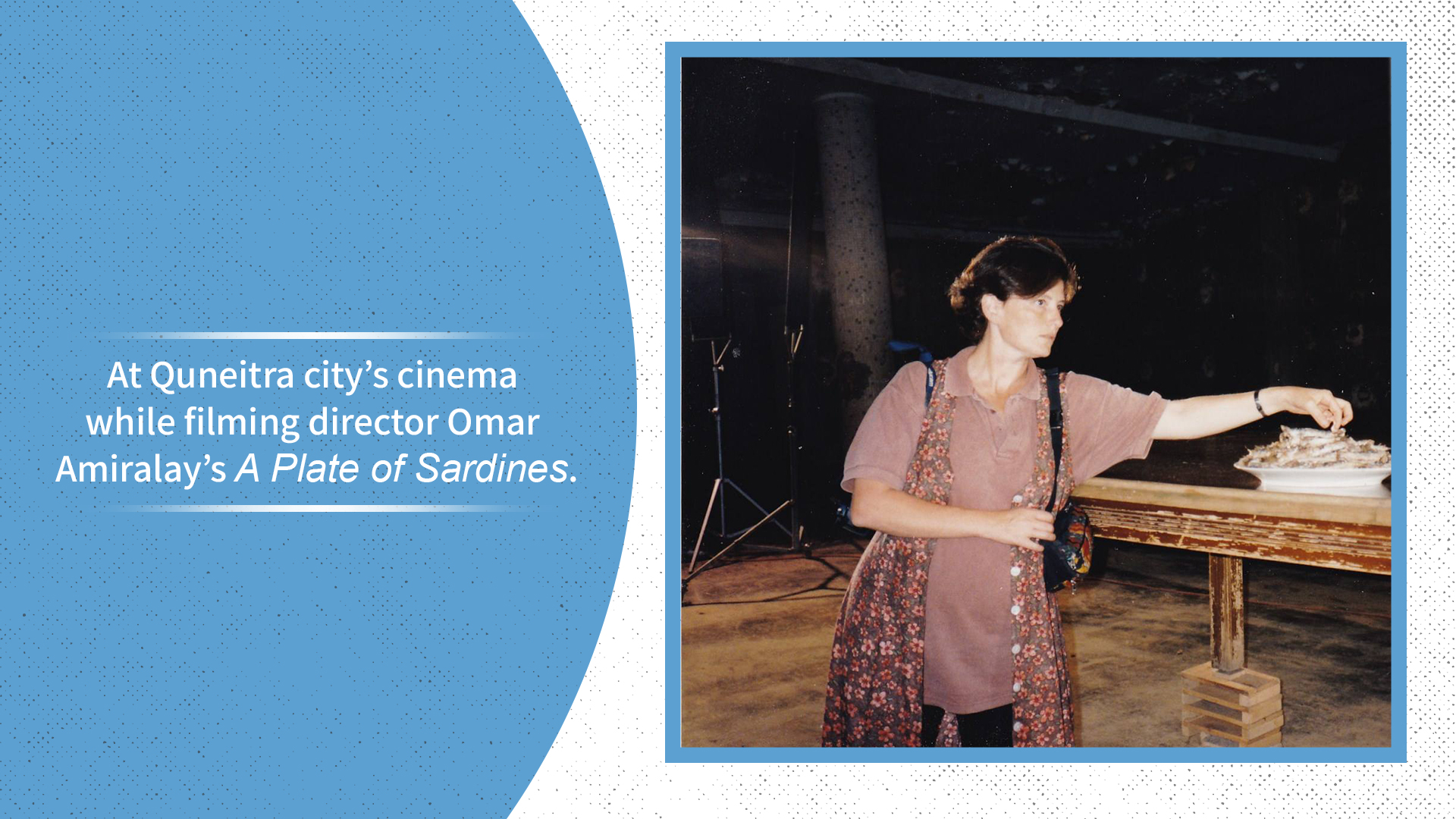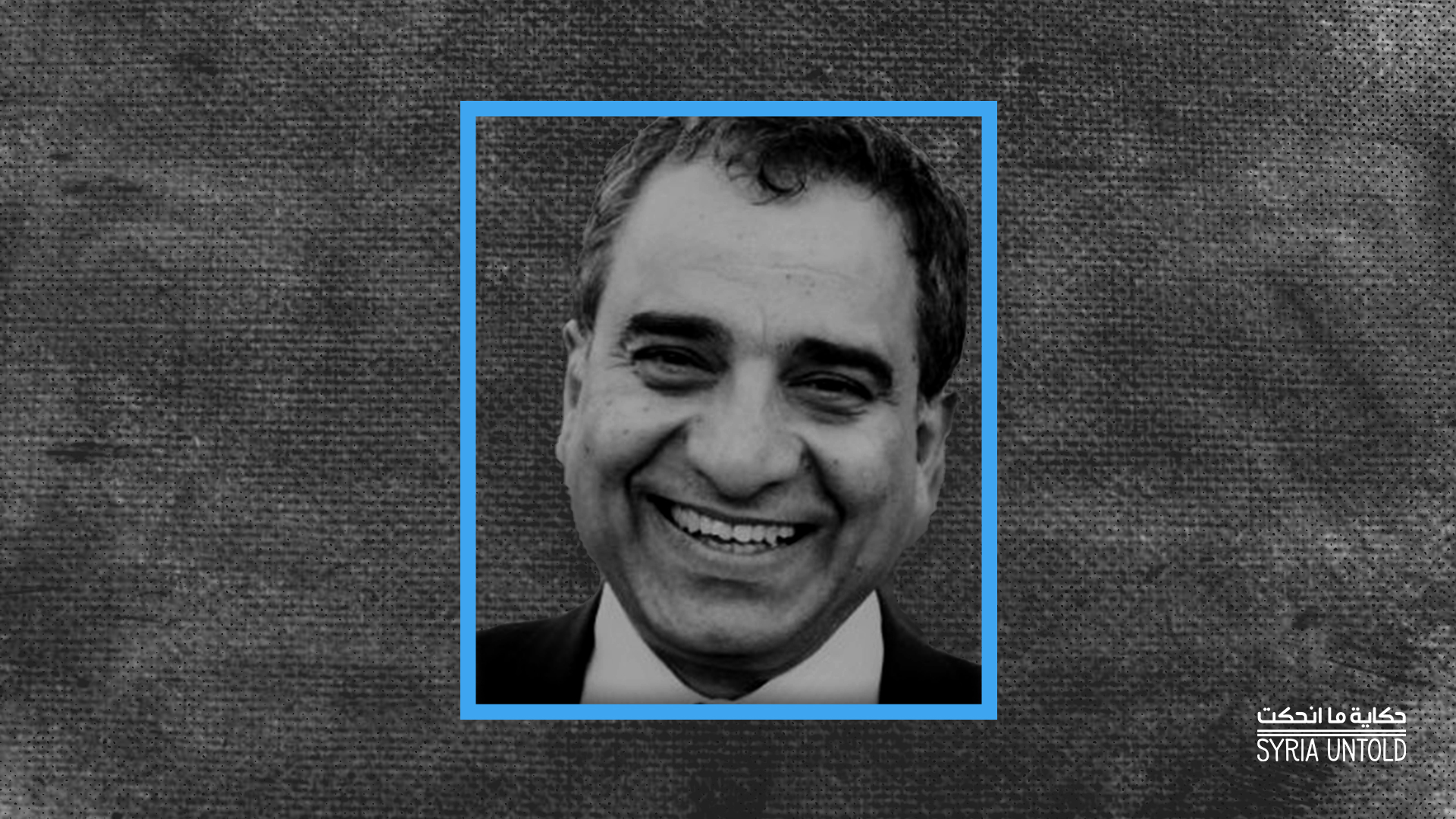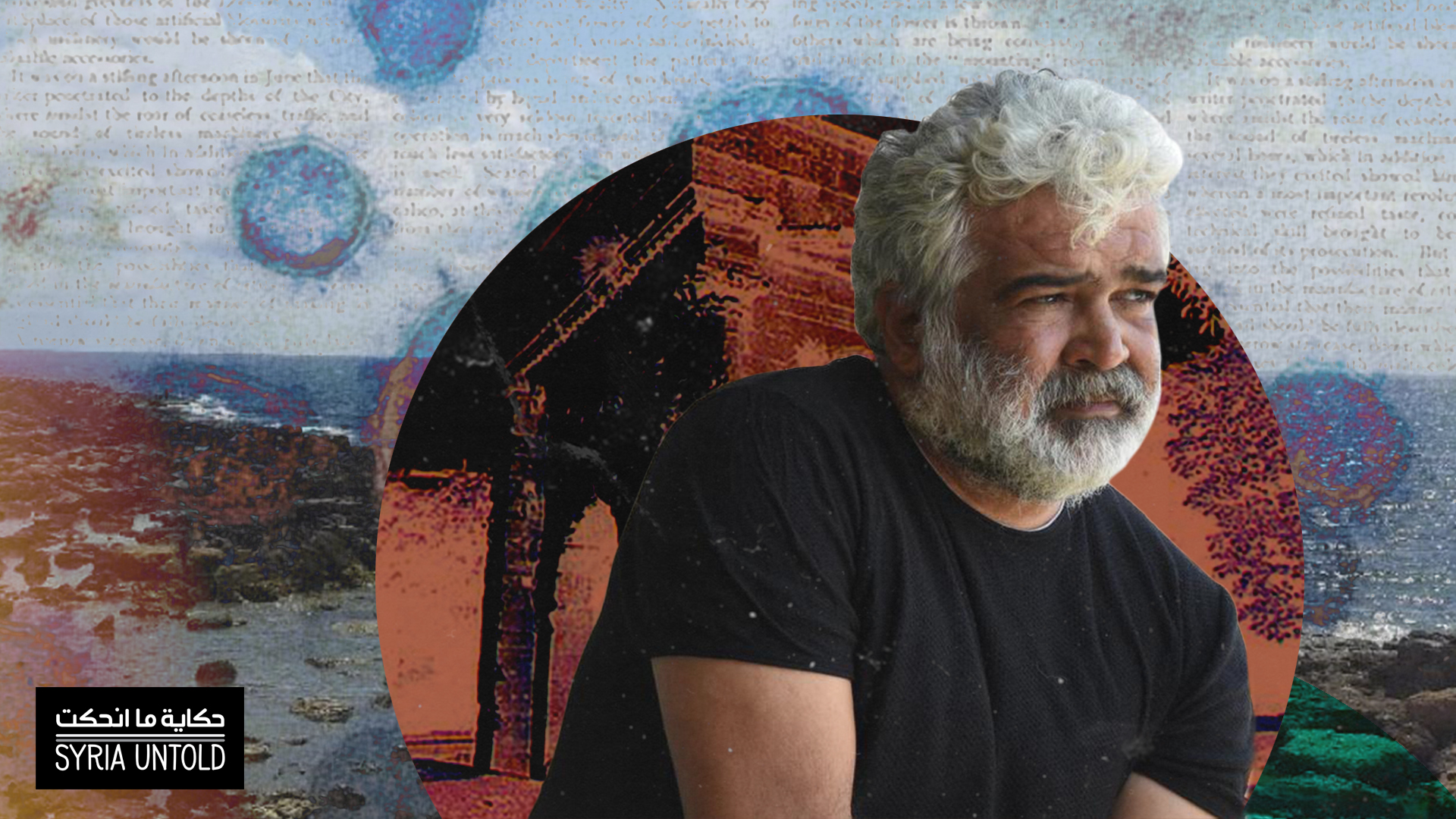Read our interview in its original Arabic here.
Hala Abdullah is a prominent Syrian cinematographer, and, since the 1970s, has been among the fiercest opponents of the Assad regime. “I grew up obsessed with collective work and struggle against the regime,” she tells SyriaUntold. “I always sought innovative tools for my work, which was covert, forbidden and under threat. Cinema became my hope to publicly unveil this struggle.”
I was late to meet Abdullah and her work, finally finding her in 2011, when access and communication became easier for Syrians. This was thanks to social media and Syrians’ desire to meet others in the wake of the openness that the revolution engendered. I was also increasingly interested in Syrian cinema and its history.
I only met Abdullah twice, but I saw many of her films, and we have been Facebook friends for a long time. She was always kind, modest and loving. My great admiration for her long cinematic career drove me to conduct this interview with her.
Our dialogue went on for several weeks through emails, Facebook messages and phone calls, until we reached the final version below.
Milestones in Abdullah’s life:
Correct me if I am wrong, but you have been living in France for years, yet you refuse to apply for French citizenship. I am well aware that the Syrian revolution was a pivotal event in your life, as it was in the lives of many Syrians. How would you describe your relationship and bond with Syria? What does Syria mean to you, after all these years of living far from it?
It is true that I have been living in France since May 1981—for 40 years. I still renew my permit every 10 years, and I have not asked for French citizenship for several intertwining reasons.
But I must say, I do not live the anguish of estrangement, instability or the “this is not my place” struggle. I love Paris, and my daily life is not ruined by a feeling of being a stranger in the city. Obtaining citizenship is not the criterion for the feeling of estrangement or its absence. Citizenship is an administrative service, just like any other service and privilege granted by the French political and social system for its residents. So far, I have not asked for this service or any other services or assistance.
Within the margins, and breaking free: Syrian cinema
23 January 2021
Randa Baath: 'Any cultural act is vital'
12 March 2021
I am comfortable with a life that does not involve taking advantage of a place I was willing to leave one day. Paris gave me so much without my having to ask, such as the perks of cultural and artistic life or the feeling that I could do everything I wanted freely without being French.
Since my first day in Paris and up until this moment, I haven’t felt that this country is my own. I always feel my stay here is temporary and transient and that I am bound to return to Syria one day.
My feeling of not belonging here is strange, knowing that I have lived here twice the number of years I lived in Syria. But this feeling doesn’t bother me, and it doesn’t cause me any stress or practical problems.
In this transience, Syria was my constant. It was always present, and returning to it topped my list of priorities. I always treated my yearning for Syria by traveling to it. I missed my parents, friends, the places and the smells, and I travelled to feel them again. My work in cinema allowed me this constant mobility. In addition to participating in several Syrian films, which took a large part of my life, I also accompanied the team on French projects that were filmed in Syria, apart from my personal films which I produced in Syria before the end of 2010.
Between 1981 and 2011, I was banned from traveling to Syria. This isn’t a joke; it’s a surreal truth. For 30 years, I lived officially and legally in France, but whenever I reached the Syrian borders from Paris, I would receive a paper from the border officer summoning me to his office and informing me that I had to check with the security branch in Damascus within 48 hours and that, to be able to leave Syria, I needed a letter delivered to him to grant me the right to a one-entry trip.
This was an inevitable nightmare with each entry and exit, but it did not hamper my insistence on traveling to Syria many times every year during these three decades. This friction, that return, those short stays were all like doses of oxygen to stimulate the heart, whose pulse would not have beaten without them. They were all like refreshments for my soul so that it would not dry up. They were a necessary charge for my story with Syria to continue through the umbilical cord which can only be cut off by death.
I always feel my stay here is temporary and transient and that I am bound to return to Syria one day.
My last trip there was on February 5, 2011—the day my dear friend Omar Amiralay passed away.
After the 2011 revolution, things changed radically. I could not travel anymore because this adventure had become very expensive. That paper that I was receiving at the border came with the risk of prolonged imprisonment—the idea of indefinite arrest or final absence.
The onset of the revolution gave me a tremendous breath of life that somehow compensated for the travel ban, but it changed my relationship with my country.
I have not traveled to Syria in 10 years, but I have become haunted by Syria and its fate. Since March 2011, many years have passed, with my eyes closed, led by the light of the revolution, day and night. I sharpen my imagination, energy and life experience to continue working for Syria and its revolution. With one hand, I hold the thread of cinema, which I fall back on to persist, and with the other hand, I search for honest, free hands beating with life to accompany them on this difficult path.
Returning to Abu Alaa al-Maari in our year of plague
13 May 2021
Songs of nostalgia in New York City’s long-lost ‘Little Syria’
05 March 2021
The first film you directed was in 2006 (with the exception of Over the Sand, Under the Sun that you co-directed with Muhammad Malas in 1998), although you finished your film studies at the end of the 1980s. Weren’t you late to direct your first film? I know you have written and produced other films, but as a director you started late. What kept you from starting early?
Since my youth, I became aware of the need for political commitment to an anti-regime movement, and I belonged to a group of small working circles. Together we read Marxism and privately debated how we could expand, move and become more aware and powerful.
During my high school years in Damascus, I was active with other young women, one of whom followed [Khalid] Bakdash’s path, while the other followed the track of the political office of Riad al-Turk. I took a slightly farther direction in terms of the cells we formed with many leftist groups at that time, called the League of Communist Action. Several years later, the name was changed to the Communist Action Party.
From my political interest, I turned to cinema. I grew up obsessed with collective work and struggle against the regime. I always sought innovative tools for my work, which was covert, forbidden and under threat. Cinema became my hope to publicly unveil this struggle.
I lived in the Shaalan area at the time, and I found out through a friend that the al-Taliani neighborhood housed a cinema club, which showed “progressive” films that were boldly debated after the screening.
I started frequenting the club out of curiosity, and it was often difficult for me to stay long hours in that cinematic basement. I solved this issue by skipping the film and only going after the screening to listen with amazement to the heated and enriching debate, and to get acquainted with another form of opposition. One of the club’s main supervisors was Omar Amiralay.
After I graduated from high school, I decided to study agricultural engineering, not out of interest in agriculture, but for purely political reasons. I was convinced that the country needed an agricultural revolution.
Years later, I was pursued because of my political activities, twice. After my release, I waited for [Syrian artist] Youssef Abdelke to be released from prison. We got married and traveled together to France to study.
After prison, I completely forgot about agricultural engineering and the agricultural revolution. In Paris, I studied various fields, and I finally reached cinema, which was at the time just like agricultural engineering for me. It was my way to participate in the struggle against the political regime in Syria.
In cinema, I was fascinated by teamwork, solidarity and cooperation among all members of the team to accomplish an artistic production. I was fascinated by the ability to express, in an attractive artistic way, ideas that may otherwise be dry and difficult to grasp. I was amazed by how a Syrian film could talk about a small corner in a small neighborhood of a small village and steal the attention of the audience and influence them, although they were thousands of kilometers away, geographically, artistically and culturally.
After prison, I completely forgot about agricultural engineering and the agricultural revolution. In Paris, I studied various fields, and I finally reached cinema, which was at the time just like agricultural engineering for me. It was my way to participate in the struggle against the political regime in Syria.
For all these reasons, I shifted to cinema. I embarked on my cinematic career for political struggle first, and for partnership with the collective achievement of an artistic work, second. For many years, I did not care if the movie I was working on was my own or someone else’s. I was deeply curious to learn, and I had an unlimited desire to give. I deeply believed that this was my means of resistance. From 1985 to 2005, this is how I worked with and for other people's films. They were 20 years of immense pleasure, insane exhaustion and unlimited professional benefit. I didn't count anything; not the days nor the gains nor the losses, and I was deeply convinced that I left an imprint of my soul on every film I worked on, whether its producer admitted this or not.
Then, one day, I became aware of the accumulation of my personal unfinished film projects, as I was nearing the age of 50. So I stopped and completed my first feature film about this experience, and I spoke with my friends Raghda, Fadia and Rola about our dreams that had not been fulfilled and my unachieved film projects that had waited for me for a long time. This is how I Am the One Who Brings Flowers to Her Grave saw the light. After this film, I worked on producing more of my own films, in addition to helping others make theirs. I increasingly focused on training young men and women in writing, developing and implementing their projects.
All your films have a romantic touch, starting from the title, up until the picture, the frame and the montage technique (like in I Am the One Who Brings Flowers to Her Grave). Can you explain your cinematic choices? Why this romantic touch?
I don’t think my films have a romantic touch. Perhaps if we must classify them, I would say they are in between politics and poetry. I like the classification in French, as it is translated with two similar yet different words: poetique [poetic] and politique [political].
My cinematic choices are voices inside me screaming for me to listen. When I do, they spring out of me and impose themselves on my productions. They are only controlled by freedom. During the years I worked with others, I learned many things, from Osama Mohammad’s Noujoum al-Nahar [Day Stars] until this day. I am still getting acquainted with the profession, its difficulties, impediments and charm. At the same time, I am learning about what I should not do and repeat in my own productions.
Since 2006, the only benchmark for my movies has been freedom. My inner voice is the bridge that I build between the intimate, the subjective and the personal on the one hand, and between the general, the real and the political on the other hand.
Land, revolutions and lessons from Syria
04 May 2021
Long night to resurrection
05 February 2021
A spirit combines these two extremes and leads to creating the film, in form and content. I exercise freedom in my films by crafting scenes and montage, and I do not abide by any limitations or rules. I do not believe in a single genre, nor in the barriers between genres, and I allow myself in my own films to follow nothing but this inner cry and the joy of unconditional freedom.
I heard many questions about the nature of my artistic choice after my first film. I worked for a long time with Osama Muhammad, Muhammad Malas and Omar Amiralay, who of course were big names in cinema, and I learned so much from them. But in the end, my film was different and strange from their cinema. I decided that I would not be a copy of any of them, and this film was my own free cry. To accomplish it, I collaborated with Ammar al-Beik, who was from the cinematic sphere and from politics. He was very curious to venture into this new experience.
I also heard many questions 10 years later, in 2016, I completed my film Besieged Like Me about Farouk Mardam Bey. Those who were familiar with my productions wondered how I had deviated from my genre, which was showcased in my previous films, by mixing the private and the public, the documentary and the narrative, and the intimate and the political. Besieged Like Me was completely different. Of course, I was aware of this difference and I intended it. It was clear to me that this film carries the message, the saying and the discourse of a mature, real, suffering and worried man who has sufficient knowledge to narrate the Syrian story. I wanted it to be a clear and evident narrative.
Yes, in this movie I gave up all the joy of the previous adventure that I was experiencing in making my films, by breaking the barriers between genres and intertwining the subjective with the general and leaving many loose threads and outlets for the spectator to view the film from whichever angle he wanted. Besieged Like Me was a clear reflection of what I believed in: a life of freedom and dignity that has been confronted with unlimited injustice and violence. At the time, this was the only nagging voice inside me, and I was confident that Farouk Mardam's voice in this film was mine as well.
In my latest film, which has yet to be shown, Omar Amiralay, Sorrow, Time, Silence, I once again ventured into the content and form of the narrative.
I was deeply convinced that I left an imprint of my soul on every film I worked on, whether its producer admitted this or not.
How can we face the violence of the world through films? How can cinema be a resistance tool in the face of a regime of violence and tyranny, in a state like Syria under Assad?
I am not claiming I can face the violence of the world with a film. But, I believe in the energy and power of cinema to create and impact and stir action. I believe in its ability to light the darkness and expose violence, to alert viewers to what is happening in that country and to provoke them and awaken their consciences.
I believe in cinema as a means of resistance, to take a stand against violence in all its forms, and also to resist death and personal nervous breakdowns. I am aware and I admit that my films rescued me and held my hand to prevent me from falling into deep depression because of an overwhelming feeling of debilitation.
From abroad, we saw what was happening in Syria, since the first hours of the revolution in March 2011. We tried by all means, including cinema, to support the young men and women who dared take to the streets to call for freedom and dignity and who were risking their lives to take photos of the events and send them abroad for publication.
For these young men and women, their action was an additional form of resistance and self-protection. Those who risked taking photos and then risked sending them abroad were well-aware of the real danger that might lead to their detention or death. But, perhaps subconsciously, they knew they would be stronger and have more faith in the effectiveness of their achievements if they remained alive.
Wael Sawah: 'I sacrificed literature for politics'
26 May 2021
In the first months following March 2011, when I was participating in activities about the revolution and organizing screenings of these rare jewels (yes, this is the value and importance I felt they had), I would present them as the creator's documentary cinema, which angered some researchers and academics. But I believed in what I was saying and defended it, because whoever raised their cell phone and recorded a moment they lived with all that pleasure and danger is worthy of being called the creator of their own film, amid fear and an overwhelming desire that recognizes the necessity of this action at that particular moment. This is how the creators’ spontaneous documentary cinema emerged, and this is how activists and protesters faced the violence of the regime with their cinema in the beginnings, when the image narrated the heat of the moment, live. This act frightened the regime and fueled its appetite to pursue, arrest and kill them.
Later, their images took on a new, important and basic role, which is testimony and archiving. Their impact perpetuated beyond the filming, and was not limited to an instantaneous informative media role. This resistance to violence now had a future that was based on accountability, justice and eradication of the rights of the martyr, the injured, the victim, the abused, the wounded, the arrested, the looted, the expelled, the persecuted, the missing and the displaced. In this future, in which justice will prevail, the role of photos, documentation and archiving will be great and decisive.
Likewise, cinema will also be a tool of resistance in the face of the regime of violence and tyranny in Syria, when a young man or woman adopts it as a tool for expression and gets to know its worlds and its secrets, and thanks to it, becomes capable of expressing their internal desires, thoughts, stories and feelings simmering. Thanks to cinema, they will hear and recognize their inner voices and express them freely and in their own ways.
What an amazing form of resistance!
This is a cliché question that I normally do not like, but I feel it is inevitable. Before the revolution, Syrian cinema was dominated by men. Few female directors can be found in the history of Syrian cinema. After the revolution, many Syrian female directors emerged, and they are presenting Syrian films in international theaters. What is your take on women’s presence in Syrian cinema today and throughout its history?
I do not agree with you that this question is cliché. It is an important question and a topic worthy of being tackled. Men dominate cinema all over the world, not just in Syria.
Until the 1990s, there was a very limited presence for directors like Hind Midani, Ruwaida al-Jarrah and Anisa Assaf in television productions or Antoinette Azariya in cinema. Some professions were shared by men and women, like montage, makeup, costume and script design. But lighting, shooting, producing, sound engineering, audio mixing and script writing (except for Amal Hanna’s contributions) were monopolized by men for unknown reasons. In some rare cases, women competed with men and took over directing.
I believe in cinema as a means of resistance, to take a stand against violence in all its forms.
A few years before the revolution, some women in Syria began to impose their presence in creating feature or documentary films, like Waha al-Raheb, Alia Khashouk and Rim Ghazi, and in series, such as Waha al-Raheb also, Rasha Shurbatji and Inas Haqi. During that period, female scriptwriters of television series had a remarkable and robust presence.
When the Syrian revolution emerged with its key concerns, freedom and dignity, Syrian women played an important role in all sectors and on all levels.
Revolutions emerge to advocate for the oppressed and the downtrodden. In our country, and in every region around us, women are subject to three-dimensional oppression: oppression of the ruling political regime, oppression of the patriarchal system and religious oppression. For that reason, Syrian women’s participation in the revolution to protest this three-dimensional oppression was expected and inevitable.
At the level of art and culture, there was a radical change among the youth who were deprived of the freedom of expression, the possibility to seek artistic tools of expression and platforms for dissemination and showcasing of their forms of expression. The revolution made all these taboos accessible to everyone. Talents sprouted, and creativity emerged in every direction. Each time I talk about this, I imagine a wide desert that is suddenly transformed into a charming field of anemones. This is exactly how women and their cinema bloomed in this mesmerizing field.
Syria’s year of pain, through the eyes (and pen) of Khaled Khalifa
21 November 2020
A famine, a ship and a folk song that spanned borders
18 December 2020
Since the first day of protests, women participated in taking photos, documenting and archiving. I remember very well their special presence and participation in training sessions we held outside Syria to empower those who wanted to write cinematic scripts or make documentaries, among others. The three-dimensional oppression always played a role in sparking the curiosity of these women, inciting them to knowledge and encouraging them to seek a way of expression and feeling freedom.
During the past 10 years, we can confidently say that Syrian women occupied their place in the cinematic arena, just like in other arts, and imposed their productions in feature films, documentaries and experimental films, in Syria and in the diaspora.
They had an overwhelming desire to venture, to open up, to scream, to explore themselves, to defend their rights and to fight the three-dimensional oppression. But, above everything, they had a desire for freedom. Women entered this arena with volcanic power, and they will never leave it again.
Testimonies about Hala Abdullah and her cinematic productions:
In her films, Hala moves between cinematic genres and invokes the script and the changing nature of the film, until the last moment of montage. But of course, she settles in the end for documentaries which can be made at the lowest cost and do not require financial support. She works independently to show the truth she extracts from fragments of reality, ever since her first film I Am the One Who Brings Flowers to Her Grave (2006). The credibility of her films lies in the fact that they resemble, in the ways they unfold, the beauty and truth of that dark black painting that we talked about in I Am the One Who Brings Flowers, where she mixed one poetic image from the book One Crumb Satisfies Me by late Syrian poet Daad Haddad with warm human phrases spoken by the film's characters, Rola, Raghda and Fadia or Umm Youssef. These women have waited for a bleak Syrian fate, which will later mirror the fates of other Syrian women who have experienced the pain of loss, abuse and forced absence after the outbreak of the Syrian revolution in 2011.
That scene in which Hala talks with the Syrian artist Elias al-Zayyat about his work on restoring old icons summarizes her artistic and personal vision in cinematic terms. The black painting (the icon before it was restored) which is covered in dust, smog and maybe wax, resembles the Syrian reality that she chases through her films, the most recent of which is Sorrow, Time, Silence about late film director Omar Amiralay.
Light and color emerge in Hala’s films little by little, revealing to us the silent truth of the harsh reality, hidden behind the pulse of life, but sharp as a blade. All Syrians tasted the bitterness of this reality later. It is the slow revelation of the truth in exquisite cinematic poetry, chased by love, pleasure and passion, and an unveiling of the successive stages of Syria’s history, flooded in mud, and whose darkness almost matched the darkness of hell, amid all the futility, injustice and blackness, covered with murder and blood.
Her films will constitute lighthouses for others after her return to Syria, following her exile from the country because of her political activities since she was 20. These are the points that will guide us back to the same country that exiled us as punishment for demanding freedom and justice—the demands that prompted Syrians to take to the streets after decades of injustice and tyranny.
What is striking about Hala is her unique personality, which seems, at first impression, controversial.
There is her uncompromising behavior that lacks exaggerated pleasantries and reflects a leftist tradition that does not leave much room for humor or tolerance in times of seriousness. At the same time, there is the tenderness and generosity radiating from her eyes and from her camera that has always accompanied her, one notices, as soon as the relationship with her becomes stronger. It is a thin line gradually unfolding and striking balance between the two sides of her personality, despite the apparent contradiction between them.
As I recall the different scenes and reactions in the past years, Hala seems to me one of the most prominent characters in a film that many participated in writing and acting. But, it was up to her to imagine the arrangement of the paragraphs and the composition of the colors.
The truth is that after I met Hala two decades ago in Beirut or Damascus, I got to know her again in Paris after 2011, in the wake of the Syrian revolution and the resulting circles that brought Syrians in exile and immigrants from Arab countries together with French people who had lived in Syria or had discovered it and supported it at the moment of the popular uprising. Ever since, I do not remember participating in an activity, demonstration, symposium or evening where Hala was not present. She participated in some way, whether in organizing the event, preparing for it, disseminating the invitation or forging links with those who could be a point of reference and support for Syrians. This is what always made her, with her blazing eyes, a witness to the outcomes of joint action, and an observer of its gaps, successes and pitfalls.
As I recall the different scenes and reactions in the past years, Hala seems to me one of the most prominent characters in a film that many participated in writing and acting. But, it was up to her to imagine the arrangement of the paragraphs and the composition of the colors. I think that her latest film, Besieged Like Me, constituted in two of its three dimensions, an embodiment of that idea exactly. The Syrian issue occupied one of the dimensions, and the friendships, human connections and political commitments woven around the table of our beloved Farouk Mardam Bey, thanks to both Hala and himself, constituted the second dimension. As for the third dimension, which is that of the camera and filming, she painted it herself. She opened up to us and among us.
I am deeply grateful to Hala for her honorable presence and friendship, and I hope that one day she will complete the aforementioned three dimensions with a fourth one of her choosing to document for us the journey of return or crossing to Syria, and the renewed encounter under its skies.
I can only talk about Hala’s movies as a spectator, better yet, as an external spectator. For several years, I have been involved in research questioning the images of struggle in the MENA region since the 1970s, the revolution years and now. Hala was always there in her capacity as a producer. In Syria, no women had directed films until Hala grabbed the camera.
When I first discovered her films, I was struck by the audacity of the image, in which she relentlessly tested the political power of cinematic expression. After being taken in by politics, Hala was forcibly displaced, and she chose Paris to settle down in. At the age of 50, she asserted herself as the pioneer of Syrian documentary film.
In the middle of the first decade of the 21st century, Hala showed her rebellious character through her own gestures and insinuations, denouncing the regime that oppressed and persecuted her and others.
Hala adds her voice to her pictures to better shed light on the testimonies of the persecuted, emphasizing the violence of exile and the political turmoil that sucks in those who are forced to flee. She does that through stories that challenge narrative sin, coupled with a special poetic and personal testimony that better translates the need for alternative cinema, which lives on despite the distance.
Hala follows in the footsteps of alternative cinema for those who made images before her in the region. And, like a few others, she depicts the issues of the era in which she began making her films. Her prolific and thrilling films seem, to me, a breakthrough that the younger generation of filmmakers have rushed to, having inherited from such films the acceptance of the profound human weakness that makes these films universal.



